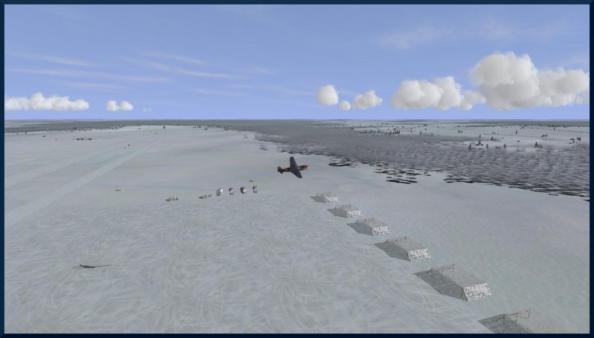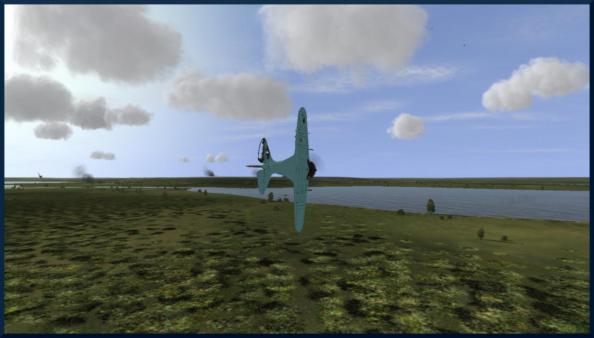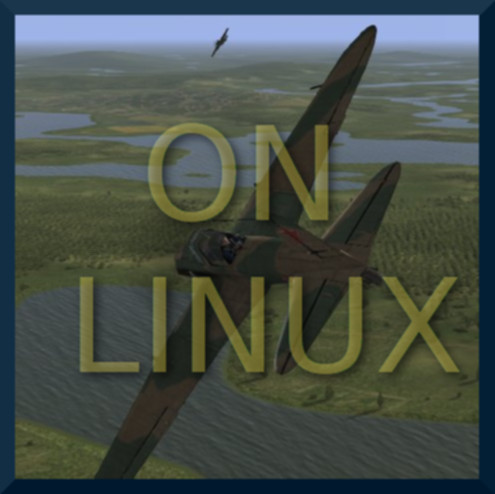FliersHaveMerit
Fliers have merit, those meritorious fly, those who don't fly have no merit!
IL- 2 Sturmovik: 1946
Nearing the end of the second millennium AD, a debate developed relating to the best way of presenting the experience of World War II pilots to PC flight simmers. Back in the day, the genre was still blooming and titles such as European Air War, Jane's WWII Fighters, Combat Flight Simulator, Combat Flight Simulator 2 and 3 or simulators dedicated strictly to online play like War Birds and Aces High were very popular and the topic of the discussion was the possibility of modelling flight characteristics of modelled aeroplanes better, of producing better graphic depictions and, to put it shortly, improve upon every perceived shortcoming of contemporary PC flight simulators. About that time Oleg Maddox, an aviation engineer who emigrated from Russia to Britain, started his work on a flight simulator popular even today and through which he delivered, more or less, all PC flight simulator enthusiasts were wishing for. The first incarnation of this simulator was published in the year 2001. under the name of IL- 2 Sturmovik and has, over the course of years, through a number of patches and add on packs published for it by Oleg's team as well as by a group named Team Daidalos which continued developing this simulator after Oleg and team moved on to other projects, evolved into a title which presents the user with a considerable number of flyable aeroplanes, perhaps it would not be an exaggeration to state all significant aeroplanes of WWII era as well as some less significant ones, an advanced flight model, all significant theatres of operations, a dynamic campaign, custom built scripted campaigns, single missions and a mission builder all on a single DVD. As if all this wasn't enough, mods which can be installed on top of the IL- 2 Sturmovik: 1946 simulator bring a map of Britain, fighter aeroplanes such as Spitfire marks I, II, XII and XIV, Hawker Typhoon, FW- 190 A3, Bf- 109 E3 and others, a map of Korea and models of F- 86 and MiG- 15 jet fighters, and there's also a mod called Jet Era which provides for flying third generation jet fighters like the MiG- 21, F- 4 Phantom, F- 8 Crusader and a few others.
IL- 2 Sturmovik: 1946- full mission builder user interface
Mission editor incorporated into IL- 2 Sturmovik: 1946 provides for creating single missions for online and offline flying as well as for creating scripted campaigns. All significant WWII era theaters of operations have been made available to the user: former USSR, Europe, Pacific, Far East and Africa. By selecting the "Pilot career" option and configuring additional details one can start the dynamic campaign which puts the simmer into the role of a pilot of one of WWII period air forces. This dynamic campaign doesn't allow for the outcome of the war, or even a more significant battle for that matter, to be reversed which means that major events will unfold as they did historically, but it is possible to get an impression of what flying during the more significant battles was like and perceive how success or failure in mission completion influences the local development of the situation. The IL- 2 simulator, as soon as it was published, had separate AI algorythms designed to mimic individual flying styles of famous WWII aces and, as a consequence, one could find oneself shot down by a digital version of a famous ace over the course of a dynamic campaign. Those wishing to prepare themselves for such an event may do so by selecting the apropriate ace as the opponent while creating a "Quick mission", selectable as an option from the main menu which also provides for selecting the number of AI aeroplanes as well as their types for both own and the opposing side, skill level of AI pilots, starting conditions of the engagement, atmospheric conditions and jumping into the cockpit immediately.
IL- 2 provides for recording .trk files that represent a record of everything that happened during a simulation. These files can be viewed by selecting the "Play track" option available in the main menu which will run the simulation again with every object going through what it went through while the .trk file was being recorded. While viewing .trk files it is possible to select different outside views of different objects that appeared during the mission, which can help with unraveling an odd mistery that could have presented itself to the simmer while one was flying the mission.
IL- 2 Sturmovik: 1946- the outside world
Regarding the graphical representation of the outside world Il- 2: Sturmovik, when it was published, introduced some inovations which still make it unique in the world of PC flight simulators. This was later given up on even by the original team that worked on the development of this flight simulator, but the results achieved on the new project make an interested observer raise an eyebrow and wander whether the right decision was made, the point being the compromise made having to do with the graphical representation of forests. Forests are represented as several parallel layers of textures and, owing to this method of graphical representation, take a vary small share of processor cycles, which provides for detecting collision of simulated aeroplanes with forests. Positive influence of displaying forests one can colide with on the decisions simmers make while flying, such as the decision not to fly through forests, needs no further consideration. While it will be conspicuous that forests are displayed as several texture layers at very low altitudes, above a hundred meters already forests look more credible and probably represent the best method of depicting forests used in PC flight simulators. Grass isn't drawn over the terrain surface, which isn't a big drawback because in flight grass isn't discernable even in simulators in which it is drawn, but different friction coefficients for different surfaces are modelled, which is important while ditching an aeroplane or taxiing. A frequently audible objection that buildings in populated areas "pop up" when simulated aeroplane is situated close enough signals a concession made to small processing power of computers that existed when IL- 2 was published and has to do with level of detail settings at certain distances. Reflections are visible on the water and objects cast shadows on underlying terrain.
The display of atmospheric conditions wasn't paid any less attention to and, as a consequence, flying in overcast weather, rain, snow or under reduced visibility conditions leaves a good impression. Atmospheric conditions modeling doesn't boil down to just graphical display and, as one would expect of a serious flight simulator, interaction between the atmosphere model and the flight model exists, which means that flying through a turbulent layer of atmosphere, strong wind as well as local atmospheric conditions in general influence flying characteristics of the simulated aero plane. Atmospheric conditions, however, will not change with the flow of time over the course of a single simulation, which means that this atmospheric model can't be considered dynamic. Some mod packs available for the IL- 2 Sturmovik: 1946 flight simulator even have the possibility of switching on the modeling of the influence of the prop wash on the aero plane that flies through it, but IL- 2 with basic patches doesn't offer this possibility.
IL- 2 Sturmovik: 1946- maneuvering with a damaged elevator
The IL- 2 Sturmovik flight simulator didn't have an advanced flight model when it was published, but it was valued for the flight model it did have. Processing power of personal computers increased in the mean time which facilitated for developing an advanced flight model which is included into the content of the IL- 2 Sturmovik: 1946 DVD. Although the shifting of Center of Gravity as the fuel is consumed or as the payload is detached from the aero plane isn't modeled, this flight model was praised by some virtual pilots who happen to be real life pilots as well, first and foremost for it's spin modeling. Since most simulated aero planes are piston- engined, gyroscopic and torque moments play a significant role while maneuvering, and IL- 2 is among the first PC flight simulators which have these phenomenae modeled in such a way that a similar model was quickly introduced into some other flight simulators. The need to trim the elevator for different air speeds was usual, but now it also took trimming the rudder, while the change of the engine RPM started influencing the yawing moment whereas it traditionally only influenced the change of the rolling moment. To add to all this, the gyroscopic moment influences the yawing moment, the direction of the influence depending on whether the maneuver is being performed at positive or negative G load. And so on. Shortly put, the effects which were considered secondary in PC flight simulating before this flight model was created became significant, which made flying more complicated, but also more interesting and closer to reality. On take off and landing lift is influenced by ground effect which is, seemingly, finally modeled in such a way that no one can find serious fault with it. While taxiing, if the speed of motion allows for it, it is possible to break the landing gear by exposing it to excessive torsion induced by turning.
The engine model includes models of internal combustion engines and propellers and, in addition to that, some jet propelled and rocket propelled aeroplanes have also been modeled which, reasonably, took building models of corresponding engines. Apart from the difference between piston engined aeroplanes and jets or rocket propelled aeroplanes which, apart form the perceivable difference in performance, presents itself through the aforementioned effects related to behavior of aeroplanes in flight, the simmer who picks a piston engined aeroplane gets an opportunity to control the propeller pitch and see how the air speed and engine RPM are influenced by it's change, shift the compressor gear, adjust the fuel mixture to the current flight conditions and reach the conclusion that the throttle isn't the only instrument of influencing the speed of an aeroplane in flight unless the aeroplane comes equipped with the Komandogerrat device. Off course, things will also be a little simpler if the chosen aeroplane comes equipped with a constant speed prop and a governor, a device meant to keep the engine RPM constant most of the time, but on the other hand, so as to keep things from being only simplified and embellished, some modeled engines are carbureted and will cut out at negative G loads. Radiator shutter deflection will, for it's part, influence engine cooling but also the minimal drag and can, for this reason, be considered another air speed controlling device.
The damage model, when this simulator was published, was revolutionary for it's time which reflects in detecting collision of a round with a part of an object that is being shot at, unlike the method widely in use before, wherein collision detection of a round with a "hit box" which enveloped the object that was being shot at was performed. In the IL- 2 Sturmovik: 1946 simulator, a wing of the aeroplane which is being shot at will detach if a segment of a wing spar is demolished, the controls will fail if a control cable is severed or if a control surface is detached from the plane, which can happen as a consequence of excessive load as well, a significant component of the engine will fail if hit and so on. The damage model also includes a graphical representation of the damage inflicted at the place at which it was inflicted and a simmer will, for example, probably be able to spot a big hole in the right wing if one perceives that the simulated aeroplane tends to roll to the right with the stick centered and the controls trimmed. In addition to the damage inflicted by the damage inflicting mechanisms, damage to the simulated aeroplane can also be caused by exceeding the maximum allowed airspeed as a consequence of which loading of certain parts of the airframe will exceed the allowed values, and Team Daidalos modelled damage caused by exceeding the allowed G load while maneuvering in one of their patches as well.
IL- 2 Sturmovik: 1946- cockpit
Cockpit models of simulated aeroplanes in the IL- 2 Sturmovik: 1946 simulator aren't clickable and the low polygon count of these models represents a concession made to processing power of PC hardware available at the time this simulator was published and signals that it's almost a decade and a half old. Neither the cockpits nor the aeroplanes are self- shading. On the other hand, with a few exceptions relating only to a few simulated aeroplanes, cockpit instruments work properly. Off course, modeling clickable cockpits for each of the simulated aeroplanes in detail wouldn't have allowed for the number of simulated aeroplanes to be as high as it currently is. Team Daidalos endeavored to remove the deficiencies present in cockpit models, which facilitated for providing head tracking with six degrees of freedom in all simmer controlled aeroplanes, while before it took using the mods in order to get head tracking with six degrees of freedom in this simulator. This team introduced a model of radio- beacon navigation for planes which were equipped with such devices through one of the patches, and the possibility of listening to radio program in an aeroplane cockpit was provided for users who were industrious enough to find recordings of music and radio shows dating back to WWII period and from appropriate language region, compress this into the appropriate format and place it into the appropriate folder.
Aerial munitions dating back to World War II period, even the first guided missiles which were developed in Germany just before the war ended, are modelled truly and, it may be worthy of a mention, Team Daidalos chipped in again with modelling different types of aerial bomb fuses. Different tracer colors vissible while the simulation is running correspond to the colors used by the appropriate air- forces. Ballistics are modelled well enough to make gunnery manuals dating back to World War II period one of which was already linked to this page relevant, and a tool that can be accessed from Microsoft Excel or Open Office Calc, styled Sniper's Corner, represents an equally good choice. Bombing and aiming the rockets requires practice as well.
IL- 2 Sturmovik: 1946 represents an excelent simulator all mentioned shortcomings notwithstanding because, if we except the absence of clickable cockpits, all it lacks is some eye- candy. This doesn't represent a big drawback while flying because the attention is tied to all it's good qualities and one can, not without reason, state that good compromises were made while the simulator was in production. The simulator will work in Linux under Wine with a negligable FPS loss when compared to Windows, with head tracking provided by Linuxtrack, while Force Feedback stick support in Linux isn't researched by the author of this article. After the install from DVD is complete, installing the patches is recomended and someone may even wish to try the History mod or the Jet Era mod out.
Related to this flight simulator:
If You are ready to get pumped visit totally sweet mammels, or the following website.





